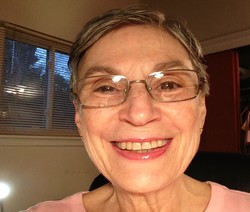In my opinion, one impediment to our connecting fully with others is our tendency to identify with our own beliefs and opinions.
I think that, for many, the meanings in the sentences, “I believe in X,” “I am the kind of person who believes in X,” and “I am my belief in X” are easily conflated.
The problem comes when somebody disagrees, or even attacks, our belief. If we believe that we are our belief in X, then we also tell ourselves that the person who disagrees with us is attacking us.
Telling ourselves that story leads to our getting ‘hot under the amygdala’, and that, life has shown us, usually does not provide durable solutions.
I can resist identifying too closely with my own beliefs and opinions by telling myself a different story: that, under certain congenial circumstances, I could also believe (or have believed) something very different than what I believe right now.
The beliefs that I call my own were created not in a vacuum but in the context of the circumstances of my life. The beliefs of other persons were likewise formed amidst the circumstances of their own lives. Had I been brought up under similar conditions, I could have started to acquire those beliefs as well.
As a matter of fact, the beliefs that I hold when sitting in my comfortable living room might differ even from the ones that I use when walking through a neighbourhood deemed unsafe. For example, in the safety of my home, I might entertain a lot of very gracious beliefs about my fellow humans. In a neighbourhood deemed unsafe, I might entertain – even temporarily – a lot of rather ungracious ones.
The beliefs that I hold, and act as a twenty-year-old, when my body was host to a throng of rampant hormones, are quite different from those that I hold, and act on today.In those days, I believed that it was important to be attractive, talented, and competitive, and to take risks. These days, I think that it is more important to be healthy and safe. Looking back, I am astonished at ideas that I held and ways in which I behaved.
Similarly, the beliefs that I used about my rights to explore the sometimes dangerous possibilities in life might be very different from the beliefs that I might hold about my young cousin’s freedom to experiment and explore the same, perhaps dangerous, possibilities.
Under some circumstances, I could hold or could have held beliefs with which I usually disagree. When we had to encourage our former landlord to return our security deposit, I told myself the story that I was generous, and he was miserly. But, in the environment in which he grew up, being very frugal was considered a virtue. Had I been brought up in the same context, I would likely have believed so, as well.
One could go farther afield, and consider people who hold racist beliefs. If we really consider the matter, many of us can recognise that our own liberal attitudes were incubated in an environment providing a high level of support for beliefs in civil rights.
But would we also have been brave enough, or imaginative enough, to entertain the same beliefs had we been brought up in the State of Mississippi, in 1820?
I believe that, under those circumstances, in a culture that feeds and supports and rewards racist attitudes, I, too, could have adopted, and held, racist beliefs.
I have often wondered if I could have been anti-Semitic, had I not been Jewish. Had I not seen firsthand the beauty inherent in Jewish customs, would I have considered those customs strange? What would I have believed about Jewish people had I been born in a peasant family in Poland in the early twentieth century?
I am providing so many examples just to illustrate that the idea that ‘I am my beliefs’ does not always make sense.
It seems more likely that my beliefs are the products of a great complexity of circumstances, any of which might have been different, and all of which are continually changing. Beliefs are entities that I can inherit, cultivate, adapt, and reject. They are also tools that help me get through the day, through both easy and challenging situations, through conversations, and through encounters with myself.
Under certain circumstances, some beliefs are important enough for me to fight, sacrifice, and die for. Even if I am willing to die for the sake of a particular belief, however, that that does not mean that I am that belief. It merely means that, at the present time, that belief is crucially important to me.
The reason why I am making this distinction is that, at the moment that I let go of the idea that I am what I believe, and entertain the idea that I could also have held many different sorts of beliefs, the world opens up. I find myself able to connect with, and talk with, and enjoy a great many different kinds of people.
I am increasingly intrigued by the idea that if we can really connect and have real conversations, we may be able to enter into a different kind of space, perhaps the Master’s own space, the simple space of beginning that fosters the working out of the complexities that we call problems.
All the forms of the universe emerged from that space, and Chariji told us that that original space was none other than the human heart.
If the human spirit can foster the universe, can it not also foster solutions to human problems?
I am discovering that, in speaking with people whose opinions differ from my own, connecting first is crucial. In practising Nonviolent Communication, we learn that nothing can be achieved in the absence of connection.
Many people, though, have a mistaken idea about connection. They think that connecting means something like being nice and friendly to another person so that they can trust us, and we can bring them around to seeing that we are right and thinking as we do.
In my opinion, real connecting is something fundamentally different. Connecting means feeling the life (the heart) in another person and connecting it with the life in oneself.
And when we connect, we give up any attachment to the outcome of the conversation. We don’t try to “get” somebody to think or believe anything. We use the courageous, radical belief that, just by allowing ourselves to connect, the space of the heart opens, and our conversations can have miraculous outcomes that we could never have predicted.
Connecting with each other, and communicating compassionately and heartfully, is simple but requires a lot of practice. Practice means doing something again and again until something changes fundamentally.
I sometimes have the idea that we are living in a kind of ‘Zen Koan’. In the world of the Koan, the practicant cannot find the solution so long as they hold to their current worldview.
When, through meditation or other forms of practice, the person connects with deeper levels of reality, their old worldview dissolves like water or shatters like glass. And once the person’s worldview changes, the solution to the Koan is immediate, quietly visible.
In my imaginary Koan world, we are all hypnotised by the idea that there are many different sorts of problems. We believe that there are those who are like us and those who oppose us, that we and those who are like us hold the solutions to the many problems, and that if only those who oppose us would either come round to our way of thinking or go away, then we would be able to make the world a better place.
We have held this idea for a very, very long time. That is how hypnosis works. But by asking ourselves seriously how well the approach has worked for us, we can begin to awaken from its spell.
I am starting to believe that there is only one problem, and that is that we are still hesitating to love each other. When we identify with our beliefs, we reinforce the idea that we are living in opposing camps, and that the other camp is the problem. In so doing, we only exacerbate the problems that our beliefs tell us that only our camp is capable of solving.
But what if all that is only a hallucination?
What if our beliefs are only images and tools, and we really don’t know any of the answers? Not a single one!
What if learning how to talk with each other is a way of opening the door and beginning to allow love to flow?
What if the real answers can come only when we are brave enough to put our beliefs aside, and allow ourselves to connect, heart to heart?
And what if, by really connecting with each other, with no attachment to outcome, we can open an infinite space in which together we awaken and discover possibilities for living that we cannot even imagine today?




leave a comment